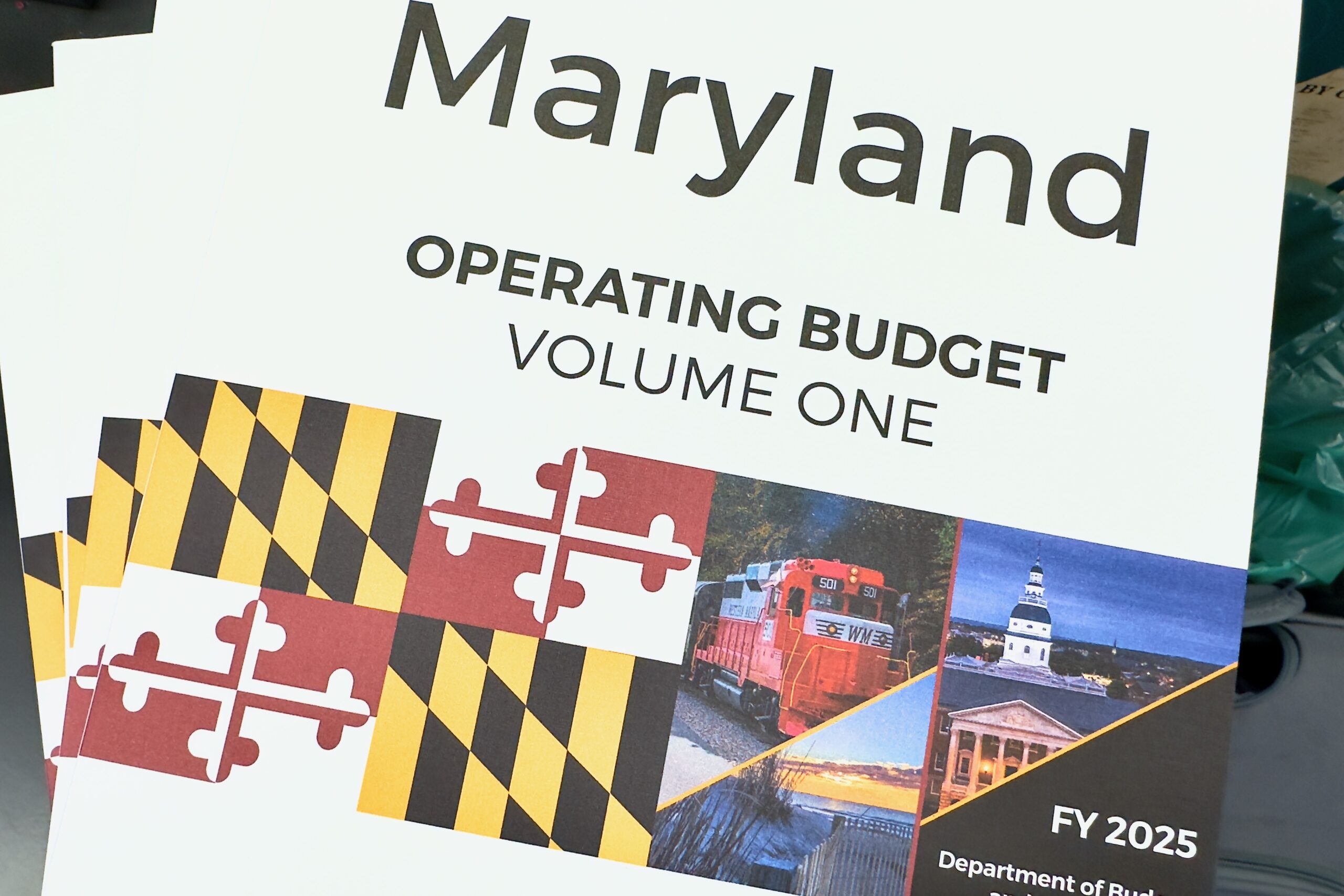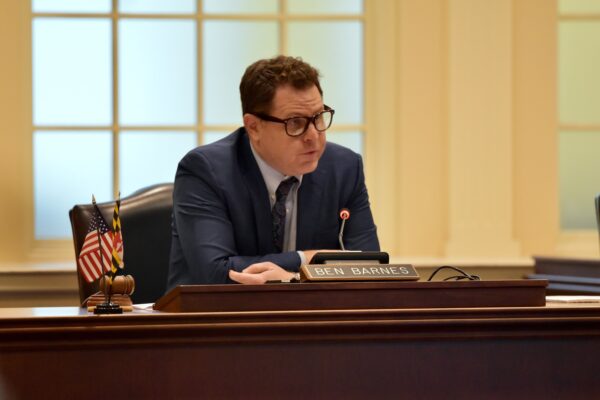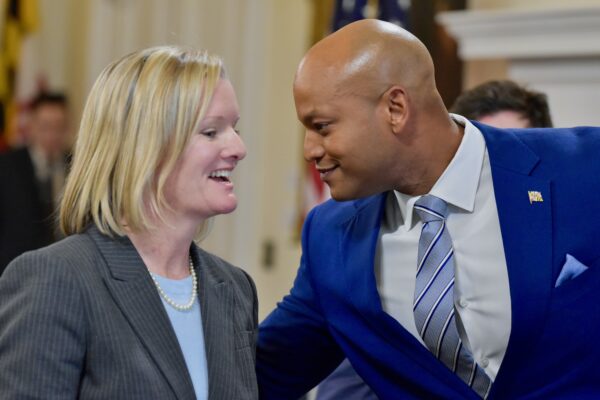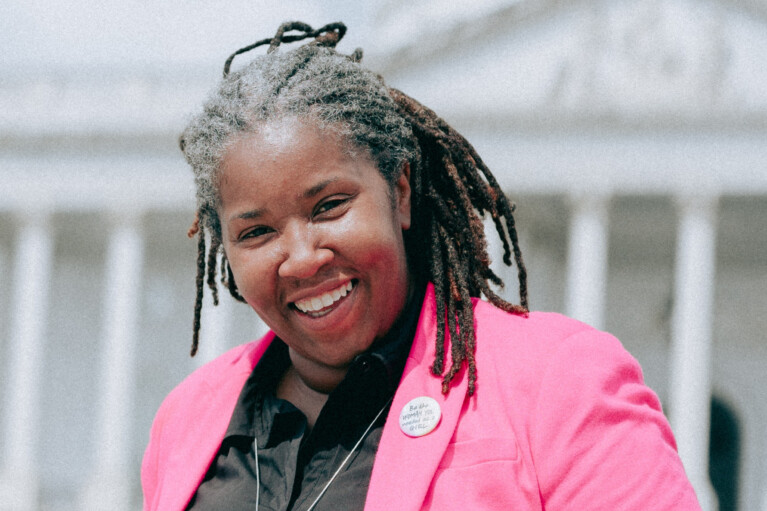Analysts: ‘A lot to like’ in Moore budget but ‘minimal progress’ on looming deficits

A $63 billion budget proposed by Gov. Wes Moore (D) resolves short-term budget concerns but does little to address billions of dollars in projected budget shortfalls in coming years, legislative analysts said Monday.
The outlook, which House Appropriations Committee Chair Ben Barnes (D-Prince George’s and Anne Arundel) called “frightening,” was part of an analysis delivered to House and Senate budget committees Monday. Billions of dollars in ballooning projected deficits over the next three years fed questions about possible tax increases.

House Appropriations Chair Ben Barnes (D-Prince George’s and Anne Arundel). Photo by Bryan P. Sears.
“There’s a lot of things that most people will like about the budget. There’s no tax increases. There’s a small amount of fees however, that come up,” said David Romans, an analyst for the Department of Legislative Services. “On the spending side, there’s a number of initiatives and enhancements, many of which I suspect will be popular. There’s also a little bit of cost containment, including some that are true ongoing reductions in funding for certain groups and it leaves a healthy balance in the rainy day fund. So, a lot of things to like. The thing not to like about the budget is that it really makes minimal progress in addressing the general fund structural deficit.”
By next year, the state’s projected structural budget deficit grows to $1 billion. In fiscal 2027, the last year of Moore’s term, it grows to $1.3 billion. A year later, it more than doubles to $3 billion — about 12% of the general fund revenues projected for that year.
“That is the largest structural gap we’ve had forecasted since back in the Great Recession,” said Romans. “Generally, we haven’t seen that kind of gap except for during periods of recession or shortly after a recession. So, it’s a particularly large challenge given that we are not coming out of recession or in the midst of one right now.”
Barnes in recent weeks has signaled an interest in looking at taxes or other revenues to address both the state’s general fund budget issues and billions of dollars in potential cuts to transportation projects.
“It’s certainly something we need to keep in mind and particularly because we’ve done so many one-time actions to resolve this year,” he said, adding that the current budget proposal replaces cash for projects with bonds, takes interest from some accounts and reduces a revenue volatility fund meant to protect the state from wild swings in capital gains tax collections.
Barnes asked Romans about the timing of potential increases and how long it would take for new money to land in state coffers.
“Revenues are tricky,” said Romans. “There are certain revenue changes that can be done very quickly. If you’re just changing the sales tax rate, for example, that’s an easy fix. Everyone’s used to paying it.”
Others might have a longer lag time.
“If there’s sort of new and creative ideas taxing a new group of services that we haven’t taxed, it just takes more time,” Romans said. “It’s going to be regulations to find exactly what you’re taxing. It will take many more months to do something new and creative than it does to just do something simple like changing a rate.”
Senate leaders and Moore have so far seemed reluctant to look at tax increases in this legislative session.

Maryland Budget Secretary Helene Grady and Gov. Wes Moore (D). Photo by Bryan P. Sears.
State Budget Secretary Helene Grady, in last week’s budget briefing, said Maryland families “are still managing the shock of the steep inflation that we experienced through 2021 and midway through 2022 in their household budgets. This has directly informed the governor’s position against raising taxes at this time.”
Senate President Bill Ferguson (D-Baltimore) said, when asked about tax increases to bolster the state’s Transportation Trust Fund, that such talks are “not going to happen this session.”
Moore entered the session facing roughly $1.1 billion in cash deficiencies and a structural budget deficit of $761 million for fiscal 2025.
Last week, Moore rolled out his fiscal 2025 budget. During a briefing, the governor claimed victory over those short-term budget challenges by flipping the cash shortfall into a $100 million projected surplus to end the year. It also reduces a projected structural budget deficit for fiscal 2025 by 34% to $502 million.
Moore manages the reversal of budget fortunes through a series of maneuvers including nearly $680 million in spending reductions the governor called “rebasing.”
The largest of those is nearly $500 million that was expected to be transferred into the state’s so-called rainy day fund, a reserve for recessionary periods and other fiscal challenges. The fund, required to be maintained at 5% of revenues, stands at $2.5 billion or twice the legally required level.
Moore will also skip $50 million in expected payments to offset the state’s retirement fund liabilities.
The governor will also cut more than $86 million from two higher education programs, including nearly $64 million from the Sellinger program for students at private colleges and nearly $23 million from a program for community colleges.
All those cuts are part of a separate budget reconciliation bill.
Moore will also tap $40 million from a fund meant to guard against wild swings in capital gains tax collections.
He will save another $35 million by reducing 6% commissions to businesses that sell lottery tickets to 5%. The plan also includes reducing the 3% commissions to agents cashing in winning tickets to 2%, according to analysts.
Another $29.3 million will come from interest earnings on some state special funds accounts.
Moore will also reclaim $1.3 million through the repeal of a small business tax credit.
Moore also transfers nearly $245 million in dedicated funds into the state General Fund.
The largest of those transfers totals nearly $150 million from a dedicated account to pay for cybersecurity upgrades. That cut comes at a time when Moore recently announced efforts to modernize state computer systems and improve cybersecurity. Some estimates place the total cost of modernization in the billions of dollars.
Also on Moore’s cutting block is a $44 million reduction to some capital projects; $40 million from an unemployment insurance fund for state employees which analysts said was overfunded; nearly $11 million in combined reductions from a fund a state pediatric cancer fund and another fund that provides grants for community microgrids; and a $400,000 reduction to state domestic violence grants.
Moore, in his budget, also proposes several new programs including:
- $15 million for the ENOUGH Act, aimed at reducing the root causes of poverty.
- $10 million to create the Center for Firearm Violence Prevention and Intervention within the Maryland Department of Health.
The governor’s budget also adds 2,500 new state positions, analysts said. That comes on top of an overall state employee vacancy rate of 10%. The new positions layer another challenge on Moore, who wants to cut into state vacancies.
Analysts project that the state will see $100 million in salaries revert to the government from unfilled positions in the next year, a sign of just how daunting it will be for Moore to close the vacancy rate.
Moore also pumps $150 million in cash from the state’s rainy day fund reserves. The money will go to help offset the state’s financial obligations to the Washington Area Metropolitan Transit Authority and free up cash that will offset proposed cuts to the state’s Consolidated Transportation Program.
That solution also resolves only one year.
On the table for the following five years is more than $3.1 billion in proposed cuts. The state will also reduce its Highway User Revenue aid to 23 counties and Baltimore City.




 Creative Commons Attribution
Creative Commons Attribution